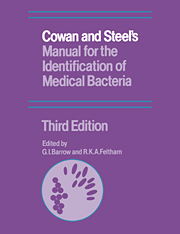Book contents
- Frontmatter
- Contents
- Foreword
- Preface to the first edition
- Postscript
- Preface to the second edition
- Preface to the third edition
- List of contributors
- Introduction
- 1 Classification and nomenclature
- 2 Culture media: constituents and sterilization
- 3 Principles of isolation
- 4 Bacterial characters and characterization
- 5 Theory and practice of bacterial identification
- 6 Characters of Gram-positive bacteria
- 7 Characters of Gram-negative bacteria
- 8 Taxonomy in theory and practice
- 9 Bacterial identification by cards
- 10 Bacterial identification by computer
- 11 Quality control in microbiology
- Appendices
- References
- Index
9 - Bacterial identification by cards
Published online by Cambridge University Press: 15 December 2009
- Frontmatter
- Contents
- Foreword
- Preface to the first edition
- Postscript
- Preface to the second edition
- Preface to the third edition
- List of contributors
- Introduction
- 1 Classification and nomenclature
- 2 Culture media: constituents and sterilization
- 3 Principles of isolation
- 4 Bacterial characters and characterization
- 5 Theory and practice of bacterial identification
- 6 Characters of Gram-positive bacteria
- 7 Characters of Gram-negative bacteria
- 8 Taxonomy in theory and practice
- 9 Bacterial identification by cards
- 10 Bacterial identification by computer
- 11 Quality control in microbiology
- Appendices
- References
- Index
Summary
Identification of bacteria is not always an art. The process of recording, collating and interpreting their common diagnostic characters can be mechanized and used in a visual sorter (Olds, 1966, 1970) based on the Peek-a-boo system (Wildhack & Stern, 1958; Yourassowsky et al., 1965). Hand-sorted punched cards have been used for recording quite varied taxonomic information (Wood, 1957) and, in the first edition of this Manual, Cowan & Steel suggested that the ‘tables could form the basis of a set of diagnostic punched cards to be used with similar cards on which the characteristics of the unknown [isolates] are punched’. Soon after that was written, Schneierson & Amsterdam (1964) described a punched card used for identifying bacteria at the Mount Sinai Hospital, New York, but unfortunately they did not give details of the ‘authoritative reference’ sources from which they obtained the characters for their master cards – information which is of course essential for assembling and using tables of characters.
A disadvantage of diagnostic tables is that as more and more detail is included they become less easy to use. For the second edition of this Manual, the early drafts of what became Tables 6.1 and 7.1 stretched to more than twenty columns with up to ten lines of characters; to check them Cowan made a set of punched cards with one (or more) cards for each genus.
- Type
- Chapter
- Information
- Publisher: Cambridge University PressPrint publication year: 1993



